In the variant design, Niva Chevrolet cars can be equipped with a four-channel airbag system
Four-channel SNPB - frontal airbag system for the driver and front passenger with a pre-tensioning device for the front seat belts.
The four-channel airbag system includes:
- - driver airbag module (DAM);
- - airbag system control unit (ACU);
- - connector with a rotating device;
- - steering wheel with a signal switch;
- - passenger airbag module (PABM);
- - pre-tensioning device for the right/left front seat belts.
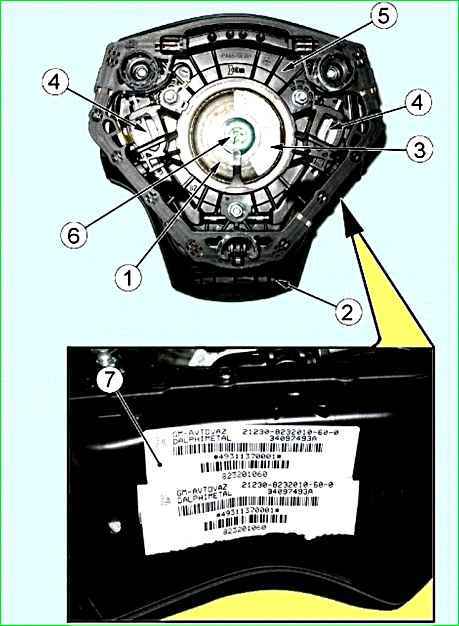
The driver airbag module (DAM), (Fig. 1), consists of a gas generator 1, a housing with an inflatable bag 5 folded into it, a facing cover 2 and fasteners.
The gas generator produces gas inside the module to fill the inflatable airbag.
The pyrotechnic substance located in the gas generator is ignited by a fuse-igniter built into the gas generator housing.
The inflatable airbag is a bag made of synthetic material built into the module housing, which is filled with gas under pressure when the module is triggered.
The inflatable airbag is folded in a special way and covered with a facing cover.
The facing cover is a part that covers the inflatable airbag and ruptures when the airbag is filled with gas along the structural seam located on the back of the cover.
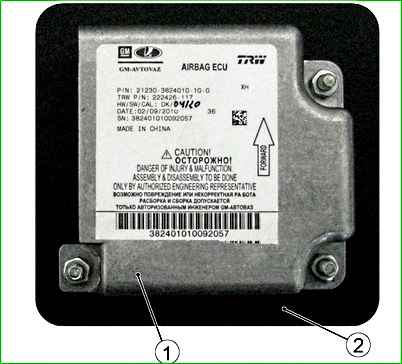
Unit 1 (Fig. 2) of the SNPB control is secured with three nuts to bracket 2 on the floor tunnel and is located under the instrument panel console.
The SNPB control unit includes an acceleration sensor and an electronic circuit for generating control signals supplied to the airbag modules and seat belt pretensioners.
The control unit converts and processes information received from the acceleration sensor located in the unit itself and generates an electrical signal to the igniter of the gas generator of the airbag module(s) and the seat belt pretensioner.
The control unit performs SNPB diagnostics, displaying the system status on the diagnostic indicator, and has software for storing fault codes and supporting the diagnostic data exchange channel via the "K" line according to ISO 9141.

The connector with a rotating device (Fig. 3) in the SNPB part is designed for electrically connecting the driver's airbag module, located on the steering wheel, to the vehicle's electrical wiring.
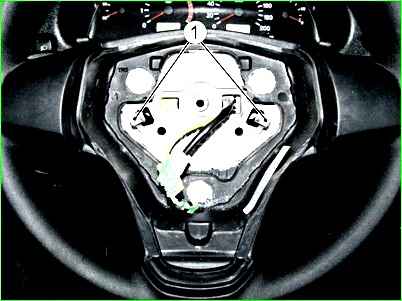
The steering wheel (Fig. 4) structurally contains retainers 1 for fastening the driver's airbag module.
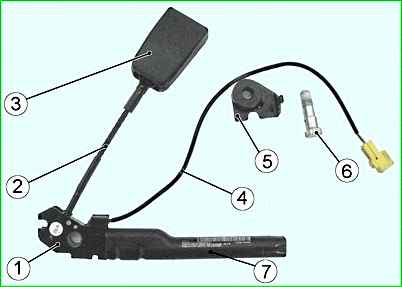
Pretensioners (Fig. 5) with a pyrotechnic element serve to increase the level of safety for the driver and front passenger in the event of a frontal impact.
The pre-tensioning devices are combined with the mounting brackets 1 and are attached to the seat runners via the spacer 5.
When the pre-tensioning device is triggered, the belt buckle 3 is pulled into the body of the pyrotechnic tube 7 by means of the steel cable 2 and is pulled back, tensioning the belt tape (not allowing the belt tension to weaken), and thus the belt fits tightly around the passenger's body.
The purpose of this action is to reduce the load on the passenger's body due to its early participation in the braking process.
In the event of an accident, the pre-tensioning devices are activated by the BUSNPB. Once triggered, the pre-tensioning devices are not restored and cannot be used again.
A new pre-tensioning device is installed to replace the triggered one.
The activation of the pre-tensioning device results in the combustion of the combustible substance.
The solid fuel produces a gas within a fraction of a second, mainly consisting of nitrogen, carbon dioxide and water vapor.
The fuel consists of solid explosives, usually in the form of powder or granules.
When the pre-tensioning device is at rest, these substances are in a sealed vessel (gas generator).
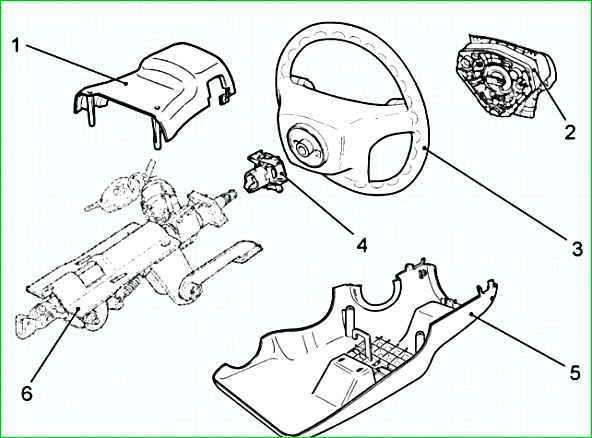
Steering control parts of Chevrolet Niva with MNPBV are shown in Figure 6





